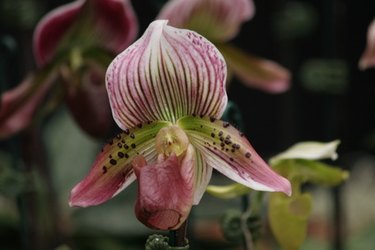
Orchids are some of the most lovely and colorful flowers. They are incredibly popular as indoor decorations. They're easy to identify since the parts of an orchid plant are very different from most other flowers. The orchid family contains around four times the number of species as there are mammal species on the planet. Understanding an orchid's parts and functions will help you identify them.
Understanding Orchid Structure
Video of the Day
Like all plants, orchids grow upward from a network of roots in an orchid-friendly medium, usually a modified soil. Unlike other plants, however, orchids have standard underground roots and air roots. Aerial roots grow out of soil in small, sticky, white tendrils. They are perfectly natural and are a good indication that your orchid likes its space. Air roots help the plant absorb moisture and nutrients from their naturally humid and tropical environment. Unless the air roots look shriveled and unhealthy, you don't need to do much of anything to manage them.
Video of the Day
The leaves of the orchid grow low from the roots. Depending on the type of orchid, they can be long and slender or thick and waxy. An orchid's leaves should all be a healthy bright green no matter their shape or variety. If your orchid gets too much light, the leaves will turn yellow. Too little light turns the leaves a dark green.
More on Orchid Growth
The orchid's stem (often called the spike or inflorescence) grows out of the leaves. Some orchid stems grow from a sheath – a leafy growth that curls around the spike for protection. The inflorescence will eventually produce the flower after growing into a long stem spotted with growth nodes. Most indoor orchids require a thin, strong stake to support the spike as it grows to its full height. If you purchase an orchid from a garden store, it will likely come attached to an appropriate stake.
Orchid plants follow one of two types of growth. Sympodial orchids are those that grow naturally sideways in the wild and will produce pseudobulbs from the orchid rhizome. This will eventually produce a sheath to support the stem and blossom. Monopodial orchids continue to grow taller and will continually produce new leaves and flowers from a central stem. While the structure of their root system differs, both types of orchids have the same general structures.
An Orchid's Flowers
An orchid's flowers grow from the stem and usually produce six petals split into sets of three. However, these petals will all look slightly different based on their function. Two large petals grow in the center of the orchid's flower and have a cup-shaped petal that grows downward, called the lip. Behind these petals are three outer sepals – one that grows directly upward, while the other two peek out between the side petals and the lip. Because of this general structure, orchids appear symmetrical on a vertical line.
The lip itself is designed for pollination and is often the most beautiful part of the blossom. The petal is designed so that pollinating insects can perch there to both deliver and receive pollen from the flower. The center of the blossom is called the column and is the main reproductive organ in the flower. The column both produces and receives pollen for germination.